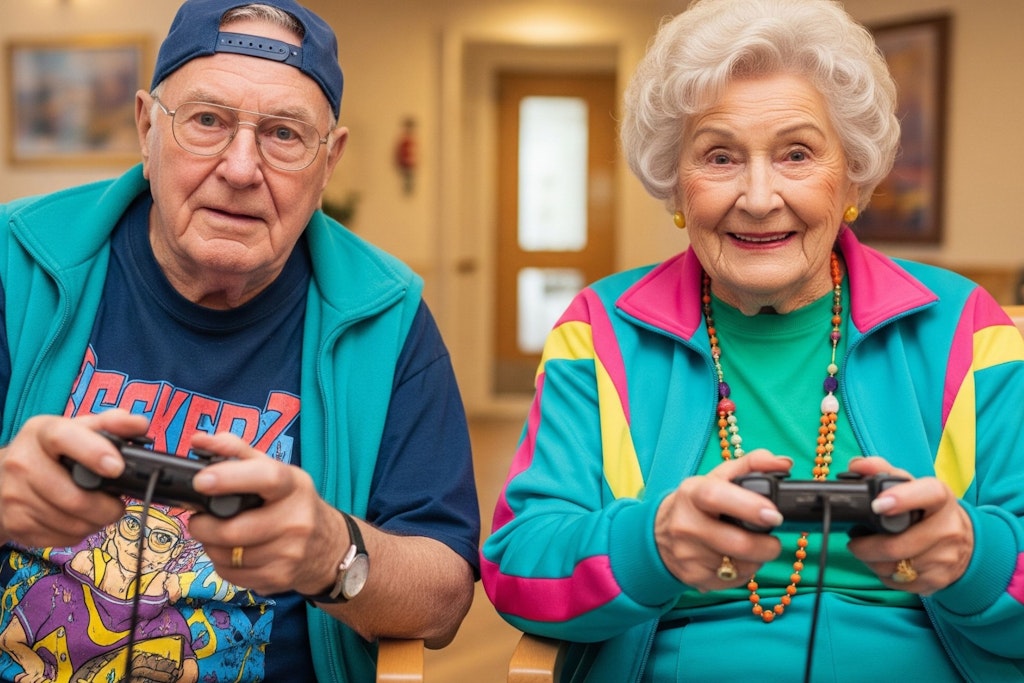Swapping Bingo for Tetris: Why forward-thinking teams should gear up for gaming
Last updated on 16 July 2025

On any given afternoon in an Australian aged care facility you will find residents gathered around tables, engrossed in a lively bingo session, the clatter of dominoes, or the quiet focus of a jigsaw puzzle.
These activities, long staples of aged care recreation, foster community and mental stimulation. But fast-forward a decade, as the Atari and Nintendo generations who grew up with joysticks and pixelated adventures begin to enter residential care – and recreational entertainment in aged care facilities may look and sound very different.
Soon, the click of bingo markers could be replaced by the soft hum of gaming consoles and the inevitable mix of triumphant cheers snarky competitive banter as the generation that grew up on Pong, Pitfall and Donkey find themselves arriving at residential aged care facilities.
The Digital Australia 2022 report reveals that 42% of Australians aged 65 and over already play video games, a figure expected to rise as tech-savvy baby boomers and Gen Xers enter aged care.
These residents, who once crowded arcades or played Super Mario Bros. on early consoles, bring with them an affinity for digital entertainment. Facilities like Feros Care in New South Wales are already trialling “Grand Gamers” groups, where residents aged 75 to 95 wield controllers for Wii Sports or Minecraft, blending nostalgia with innovation.
This trend suggests gaming could soon rival traditional activities like bingo, offering a dynamic platform for cognitive, social, and physical wellbeing.
Less glitches and lag
Gaming’s cognitive potential is well-documented, particularly for older adults. A 2019 study by the University of New England, conducted in Feros Care villages in Kingscliff and Byron Bay, found that residents over 80 who played action games like Star Wars: Battlefront twice weekly showed significant improvements in task-switching, visual attention, and working memory after just three weeks.
These gains, however, diminished without sustained gameplay, highlighting the need for regular sessions. Dr Alex Bahar-Fuchs, a Melbourne-based neuropsychologist, explains that games requiring pattern recognition or spatial navigation – such as Tetris, Monument Valley, or The Legend of Zelda – can enhance “cognitive elasticity,” potentially building brain reserve to delay dementia symptoms.
Not all games are equal, however. Research from the University of Montreal suggests that exploration-based 3D games may increase hippocampal grey matter, a protective factor against Alzheimer’s, while fast-paced first-person shooters like Call of Duty could reduce it.
Aged care professionals must therefore curate game selections carefully, prioritising titles that align with cognitive goals while avoiding overstimulation, particularly for residents with cognitive impairments.
Mind and body
Gaming’s social benefits are equally compelling, addressing the pervasive issue of loneliness in aged care. The Digital Australia 2022 study found that 74% of players believe gaming strengthens social connections, with 36% forming new friendships through online platforms.
Multiplayer games like Words With Friends or Animal Crossing enable residents to interact with peers, family, or even global communities. Intergenerational gaming is particularly impactful – facilities report residents bonding with grandchildren over Minecraft, fostering a sense of purpose and relevance.
Technologies like the Tovertafel, an interactive gaming table used in dementia care, further promote group engagement, encouraging laughter and collaboration.
For physical health, exergames like Wii Fit or Ring Fit Adventure offer a fun alternative to traditional exercise.
A Macquarie University study demonstrated that older adults playing motion-based games improved postural balance and mobility, with some showing reduced fall risks compared to conventional rehabilitation.
These games are particularly valuable for residents with mobility challenges, as they encourage low-impact movement in an engaging format. Virtual reality (VR) systems, increasingly trialled in Australian facilities, further enhance physical activity by immersing residents in active gameplay, from virtual bowling to dance challenges.
Accessibility and implementation
As the senior gamer demographic grows – 43% of Australians over 65 now play games, up from 38% in 2018 – accessibility is critical. Conditions like arthritis or vision decline can hinder participation, but adaptive technologies, such as the Xbox Adaptive Controller or voice-activated systems, make gaming inclusive.
Facilities should look to invest in these tools, alongside staff training to facilitate sessions and select appropriate games. A balanced approach, integrating gaming with existing activities like art therapy or group exercise, ensures a holistic program that caters to diverse resident needs.
Gaming as a mainstay
The data is clear: gaming offers a multifaceted approach to resident wellbeing, surpassing the scope of traditional activities. Unlike bingo, which primarily fosters social connection, gaming simultaneously supports cognitive health, social engagement, and physical activity.
With Australia’s over-65 population projected to reach 20% by 2030, aged care facilities must adapt to meet the preferences of incoming residents. This requires investment in consoles, adaptive controllers, and staff development to embed gaming into daily schedules.
Challenges remain, including the need to balance gaming with face-to-face interactions and avoid over-reliance on high-intensity games that may not suit all residents. However, the potential rewards – sharper minds, stronger connections, and active bodies – make gaming a compelling addition to aged care programming.
For leaders in the sector, the question isn’t whether to embrace gaming but how quickly facilities can integrate it to meet the evolving needs of residents.
In a few years, the familiar clatter of dominoes may share space with the buzz of virtual adventures. By adopting gaming now, aged care professionals can ensure residents not only live well but thrive in a digitally connected, cognitively vibrant future.